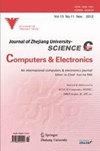Optimal placement of distributed generation units in distribution systems via an enhanced multi-objective particle swarm optimization algorithm
Journal of Zhejiang University-Science C-Computers & Electronics
Pub Date : 2014-04-01
DOI:10.1631/jzus.C1300250
引用次数: 0
Abstract
This paper deals with the optimal placement of distributed generation (DG) units in distribution systems via an enhanced multi-objective particle swarm optimization (EMOPSO) algorithm. To pursue a better simulation of the reality and provide the designer with diverse alternative options, a multi-objective optimization model with technical and operational constraints is constructed to minimize the total power loss and the voltage fluctuation of the power system simultaneously. To enhance the convergence of MOPSO, special techniques including a dynamic inertia weight and acceleration coefficients have been integrated as well as a mutation operator. Besides, to promote the diversity of Pareto-optimal solutions, an improved non-dominated crowding distance sorting technique has been introduced and applied to the selection of particles for the next iteration. After verifying its effectiveness and competitiveness with a set of well-known benchmark functions, the EMOPSO algorithm is employed to achieve the optimal placement of DG units in the IEEE 33-bus system. Simulation results indicate that the EMOPSO algorithm enables the identification of a set of Pareto-optimal solutions with good tradeoff between power loss and voltage stability. Compared with other representative methods, the present results reveal the advantages of optimizing capacities and locations of DG units simultaneously, and exemplify the validity of the EMOPSO algorithm applied for optimally placing DG units.基于增强型多目标粒子群优化算法的配电系统分布式发电机组优化配置
本文利用增强型多目标粒子群优化算法(EMOPSO)研究了分布式发电机组在配电系统中的优化配置问题。为了更好地模拟实际情况,为设计人员提供多种备选方案,构建了具有技术约束和运行约束的多目标优化模型,使电力系统的总功率损耗和电压波动同时最小化。为了提高MOPSO的收敛性,结合了动态惯性权值、加速度系数和变异算子等特殊技术。此外,为了提高pareto最优解的多样性,引入了一种改进的非支配拥挤距离分选技术,并将其应用于下一次迭代的粒子选择。在用一组已知的基准函数验证了EMOPSO算法的有效性和竞争力后,采用EMOPSO算法在IEEE 33总线系统中实现了DG单元的最优配置。仿真结果表明,EMOPSO算法能够识别出一组pareto最优解,在功率损耗和电压稳定性之间取得了很好的平衡。与其他代表性方法相比,本文的结果显示了同时优化DG机组容量和位置的优势,并验证了EMOPSO算法用于DG机组优化配置的有效性。
本文章由计算机程序翻译,如有差异,请以英文原文为准。
求助全文
约1分钟内获得全文
求助全文
来源期刊
自引率
0.00%
发文量
0
审稿时长
2.66667 months

 求助内容:
求助内容: 应助结果提醒方式:
应助结果提醒方式:


